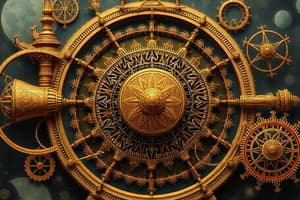Podcast
Questions and Answers
What is the focus of classical mechanics?
What is the focus of classical mechanics?
- The behavior of light
- The interactions between electric and magnetic fields
- The behavior of matter at the atomic level
- The motion of macroscopic objects at low speeds (correct)
Which of the following is the definition of velocity?
Which of the following is the definition of velocity?
- The rate of change of displacement (correct)
- The rate of change of velocity
- The force acting on an object
- The change in position of an object
What does thermodynamics primarily study?
What does thermodynamics primarily study?
- Atomic structure
- The behavior of light
- Electric charges
- Heat, work, and energy (correct)
What does Newton's first law state?
What does Newton's first law state?
What is the formula for Newton's second law?
What is the formula for Newton's second law?
What is electric current?
What is electric current?
What is the energy of motion called?
What is the energy of motion called?
What is potential energy?
What is potential energy?
What is Ohm's Law?
What is Ohm's Law?
What is the transfer of thermal energy called?
What is the transfer of thermal energy called?
What is the bending of light as it passes from one medium to another?
What is the bending of light as it passes from one medium to another?
What does the law of conservation of energy state?
What does the law of conservation of energy state?
What is the boiling?
What is the boiling?
What is the product of mass and velocity?
What is the product of mass and velocity?
What is the measure of the average kinetic energy of the particles in a substance?
What is the measure of the average kinetic energy of the particles in a substance?
Which of the following is the correct formula for mass-energy equivalence?
Which of the following is the correct formula for mass-energy equivalence?
What causes gravity, according to general relativity?
What causes gravity, according to general relativity?
What is the superposition of two or more waves called?
What is the superposition of two or more waves called?
What is the ability to do work called?
What is the ability to do work called?
What is the rate at which work is done?
What is the rate at which work is done?
Flashcards
What is Physics?
What is Physics?
The natural science that studies matter, its motion and behavior through space and time, and the related entities of energy and force.
What is Classical Mechanics?
What is Classical Mechanics?
Deals with the motion of macroscopic objects at relatively low speeds.
What is Thermodynamics?
What is Thermodynamics?
Studies heat, work, and energy, and the relationships between them.
What is Kinematics?
What is Kinematics?
Signup and view all the flashcards
What is Displacement?
What is Displacement?
Signup and view all the flashcards
What is Velocity?
What is Velocity?
Signup and view all the flashcards
What is Acceleration?
What is Acceleration?
Signup and view all the flashcards
What is Dynamics?
What is Dynamics?
Signup and view all the flashcards
What is Newton's First Law?
What is Newton's First Law?
Signup and view all the flashcards
What is Newton's Second Law?
What is Newton's Second Law?
Signup and view all the flashcards
What is Newton's Third Law?
What is Newton's Third Law?
Signup and view all the flashcards
What is Energy?
What is Energy?
Signup and view all the flashcards
What is Work?
What is Work?
Signup and view all the flashcards
What is Momentum?
What is Momentum?
Signup and view all the flashcards
What is Torque?
What is Torque?
Signup and view all the flashcards
What is Temperature?
What is Temperature?
Signup and view all the flashcards
What is Heat?
What is Heat?
Signup and view all the flashcards
What is the Second Law of Thermodynamics?
What is the Second Law of Thermodynamics?
Signup and view all the flashcards
What is Electric Force?
What is Electric Force?
Signup and view all the flashcards
What is Refraction?
What is Refraction?
Signup and view all the flashcards
Study Notes
- Physics is the natural science that studies matter, its fundamental constituents, its motion and behavior through space and time, and the related entities of energy and force.
- Physics is one of the most fundamental scientific disciplines, and its main goal is to understand how the universe behaves.
Core Concepts
- Classical mechanics deals with the motion of macroscopic objects at relatively low speeds.
- Thermodynamics studies heat, work, and energy, and the relationships between them.
- Electromagnetism deals with the interactions between electric currents or fields and magnetic fields.
- Optics studies the behavior of light and its interactions with matter.
- Quantum mechanics deals with the behavior of matter and energy at the atomic and subatomic levels.
- Relativity includes special relativity, which deals with the relationship between space and time, and general relativity, which deals with gravity.
Mechanics
- Kinematics describes the motion of objects without considering the forces that cause the motion.
- Displacement is the change in position of an object.
- Velocity is the rate of change of displacement.
- Acceleration is the rate of change of velocity.
- Dynamics describes the motion of objects considering the forces that cause the motion.
- Newton's first law states that an object at rest stays at rest and an object in motion stays in motion with the same speed and in the same direction unless acted upon by a force.
- Newton's second law states that the force acting on an object is equal to the mass of the object times its acceleration (F = ma).
- Newton's third law states that for every action, there is an equal and opposite reaction.
- Energy is the ability to do work.
- Kinetic energy is the energy of motion.
- Potential energy is stored energy.
- Work is the transfer of energy.
- Power is the rate at which work is done.
- Momentum is the product of mass and velocity.
- Impulse is the change in momentum.
- Conservation of Energy: The total energy of an isolated system remains constant.
- Conservation of Momentum: The total momentum of an isolated system remains constant.
- Rotational motion involves objects rotating around an axis.
- Torque is a force that causes rotation.
- Angular momentum is a measure of an object's rotation.
Thermodynamics
- Temperature is a measure of the average kinetic energy of the particles in a substance.
- Heat is the transfer of thermal energy.
- Internal energy is the total energy of the particles in a substance.
- The first law of thermodynamics states that energy is conserved.
- The second law of thermodynamics states that the entropy of an isolated system always increases.
- The third law of thermodynamics states that the entropy of a system approaches a constant value as the temperature approaches absolute zero.
- Heat transfer: Conduction is the transfer of heat through a material.
- Convection is the transfer of heat by the movement of fluids.
- Radiation is the transfer of heat by electromagnetic waves.
- Phase transitions: Melting is the transition from solid to liquid.
- Boiling is the transition from liquid to gas.
- Sublimation is the transition from solid to gas.
Electromagnetism
- Electric charge is a fundamental property of matter.
- Electric force is the force between charged objects.
- Electric field is the force per unit charge.
- Electric potential is the potential energy per unit charge.
- Capacitance is a measure of a capacitor's ability to store electric charge.
- Current is the rate of flow of electric charge.
- Resistance is a measure of a material's opposition to the flow of electric current.
- Ohm's law states that the voltage across a resistor is equal to the current through the resistor times the resistance (V = IR).
- Magnetic field is produced by moving electric charges.
- Magnetic force is the force on a moving charge in a magnetic field.
- Inductance is a measure of an inductor's ability to store magnetic energy.
- Electromagnetic waves are waves that consist of oscillating electric and magnetic fields.
Optics
- Reflection is the bouncing of light off a surface.
- Refraction is the bending of light as it passes from one medium to another.
- Diffraction is the spreading of light waves as they pass through an opening or around an obstacle.
- Interference is the superposition of two or more waves.
- Lenses are used to focus or diverge light.
- The human eye uses a lens to focus light on the retina.
- Optical instruments such as telescopes and microscopes use lenses and mirrors to magnify objects.
Quantum Mechanics
- Quantum mechanics governs the behavior of matter at the atomic and subatomic levels.
- Energy is quantized, meaning it can only exist in discrete amounts.
- Particles can also behave as waves (wave-particle duality).
- The Heisenberg uncertainty principle states that it is impossible to know both the position and momentum of a particle with perfect accuracy.
- The Schrödinger equation describes the time evolution of quantum systems.
- Atomic structure is determined by the arrangement of electrons around the nucleus.
- Quantum entanglement is a phenomenon where two or more particles become linked together in such a way that they share the same fate, no matter how far apart they are.
- Quantum field theory combines quantum mechanics with special relativity.
Relativity
- Special relativity deals with the relationship between space and time.
- The speed of light is constant for all observers.
- Time dilation is the slowing down of time for a moving observer.
- Length contraction is the shortening of the length of a moving object.
- Mass-energy equivalence states that energy and mass are interchangeable (E = mc^2).
- General relativity deals with gravity.
- Gravity is caused by the curvature of spacetime.
- Black holes are regions of spacetime where gravity is so strong that nothing, not even light, can escape.
- Gravitational waves are ripples in spacetime.
Important Laws and Equations
- Newton's Second Law: F = ma
- Law of Universal Gravitation: F = Gm1m2/r^2
- First Law of Thermodynamics: ΔU = Q - W
- Second Law of Thermodynamics: ΔS ≥ 0
- Coulomb's Law: F = k q1q2/r^2
- Ohm's Law: V = IR
- Mass-energy equivalence: E = mc^2
Studying That Suits You
Use AI to generate personalized quizzes and flashcards to suit your learning preferences.




